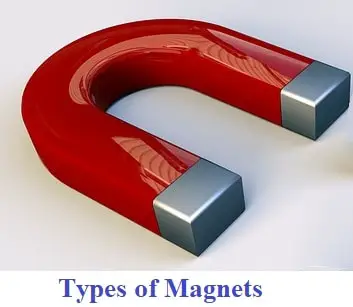A magnet is an object that produces a force that attracts other ferromagnetic materials like iron.
A magnet can also either attract or repel other magnets. Based on their characters, the magnets are broadly classified into 3 different types like
- Permanent magnet
- Induced magnet
- Electromagnet
Ancient people learned about magnetism when they discovered lodestones (or magnetite) which are naturally magnetized pieces of iron ore. They used lodestone to navigate. It was also used to make compasses.
In the 16th century, Sir William Gilbert discovered that the magnetic properties of the lodestone could be transferred to ordinary (nonmagnetic) pieces of iron by rubbing them with the lodestone.
An object is considered to be magnetically charged when the electron particles of the object all point in the same direction.

Every magnet is bipolar, which means it has two sides or poles. One side of the magnet is termed the North Pole and the other one as the South Pole.
When we bring the same poles of two magnets close to each other, they get repelled. Conversely, if we bring their opposite poles closer, they get attracted.
The magnetic field lines flow from the North Pole to the South Pole outside the magnet.
Iron metal is the first material used in making magnets. Nowadays, we can find alloy magnets and ceramic magnets. Alloy magnets make use of metals like iron, nickel, copper, cobalt, aluminum. Ceramic magnets are produced from powders called ferrites, which contain iron oxide and barium oxide.
Three types of Magnet are
- Temporary magnet
- Permanent magnet
Temporary magnet
Temporary magnets are not originally magnetic. They only exhibit magnetic behavior when exposed to strong magnetic fields. Thus a temporary magnet, unlike a permanent magnet, remains magnetically charged for only a small amount of time.
The substances that are used to make temporary magnets are usually materials with low magnetic properties such as soft iron or steel. These materials also have low coercivity.
Coercivity is the resistance provided by a magnetic material against changes in magnetization or against forces that try to demagnetize the material.
Temporary magnets are of two types –
- Induced magnet
- Electromagnet
Induced magnet- This occurs when a piece of unmagnetized magnetic material touches or is brought near the pole of a permanent magnet. The material gets magnetized due to induction.
For example, when we bring a magnet near a bunch of pins, all the pins get attracted to the magnet. But we can observe that some of the pins get attracted to the pins that are in contact with the original magnet. In this, the original magnet has magnetized the pins that are in contact with it.
The same case would occur if the original magnet was not in contact but just kept nearby, and the position of the pins was fixed. Even in this case, the pins would get magnetized.
This magnetic property lasts only as long as the original magnet is nearby. The part of the iron which is nearer to the North Pole becomes the South Pole of the induced magnet, and the opposite end becomes the North Pole of the induced magnet. This phenomenon occurs because of the presence of magnetic domains in ferromagnetic materials. This effect is temporary, and it becomes unmagnetized in the absence of the strong magnet as its magnetic domains return to a random order. Soft ferromagnetic materials are easily magnetized but may not retain its magnetism very long.
Induced magnets are used in laboratories. They are not very powerful and they lose their magnetism very quickly. This they have limited uses.
Electromagnet– In this case, the magnetic field is produced to an electric current. An electric current can produce a magnetic field. This magnetic field produced by the electric current forms concentric circles around the path of the electric current. A wire carrying an electric current is fashioned into a coil, and a piece of ferromagnetic materials is inserted into space in the coil such that the wire forms loops around the material. This is called the core. We can use iron, nickel, cobalt, etc. Usually the domains in the original core all point in random directions thus canceling out their respective magnetic fields. But when the current flows through the coil, it makes the magnetic domains in the core align with the field produced due to the current in the wire. Thus the domains start pointing in one direction, and the magnetic fields of these domains add up producing a stronger magnetic field. The more amount of electric current applied, the higher number of domains align in the same direction, the stronger is the magnetic field produced. When the current has stopped the domains again, get disordered, and thus the material gets demagnetized.
The advantages of electromagnets are that we can control the power of the magnet. We can also demagnetize it when we want to.
Electromagnets are used in industries to separate the scrap iron from other materials. They are also used in doorbells, amplifiers, etc.
Permanent magnet
A permanent magnet is made of ferromagnetic substances, which gets magnetized due to a strong external magnetic field. The material that is used keeps part of its magnetization even after the external magnetic field is turned off. This is because these materials have a high retentivity and coercivity.
Retentivity is the ability of a material to retain magnetic character even after the action of the magnetizing force has stopped or the magnet has been removed.
Permanent magnets are used in hard drives, telephones, computers, sensors, etc.